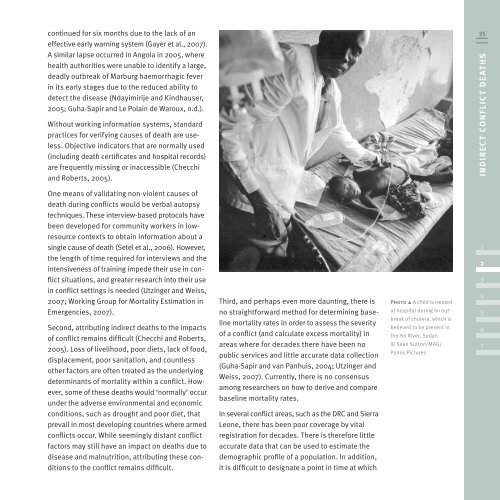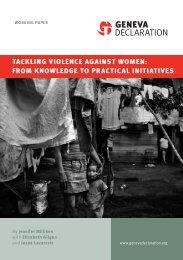Global Burden of Armed Violence - The Geneva Declaration on ...
Global Burden of Armed Violence - The Geneva Declaration on ...
Global Burden of Armed Violence - The Geneva Declaration on ...
Create successful ePaper yourself
Turn your PDF publications into a flip-book with our unique Google optimized e-Paper software.
c<strong>on</strong>tinued for six m<strong>on</strong>ths due to the lack <str<strong>on</strong>g>of</str<strong>on</strong>g> an<br />
effective early warning system (Gayer et al., 2007).<br />
A similar lapse occurred in Angola in 2005, where<br />
health authorities were unable to identify a large,<br />
deadly outbreak <str<strong>on</strong>g>of</str<strong>on</strong>g> Marburg haemorrhagic fever<br />
in its early stages due to the reduced ability to<br />
detect the disease (Ndayimirije and Kindhauser,<br />
2005; Guha-Sapir and Le Polain de Waroux, n.d.).<br />
Without working informati<strong>on</strong> systems, standard<br />
practices for verifying causes <str<strong>on</strong>g>of</str<strong>on</strong>g> death are useless.<br />
Objective indicators that are normally used<br />
(including death certificates and hospital records)<br />
are frequently missing or inaccessible (Checchi<br />
and Roberts, 2005).<br />
One means <str<strong>on</strong>g>of</str<strong>on</strong>g> validating n<strong>on</strong>-violent causes <str<strong>on</strong>g>of</str<strong>on</strong>g><br />
death during c<strong>on</strong>flicts would be verbal autopsy<br />
techniques. <str<strong>on</strong>g>The</str<strong>on</strong>g>se interview-based protocols have<br />
been developed for community workers in lowresource<br />
c<strong>on</strong>texts to obtain informati<strong>on</strong> about a<br />
single cause <str<strong>on</strong>g>of</str<strong>on</strong>g> death (Setel et al., 2006). However,<br />
the length <str<strong>on</strong>g>of</str<strong>on</strong>g> time required for interviews and the<br />
intensiveness <str<strong>on</strong>g>of</str<strong>on</strong>g> training impede their use in c<strong>on</strong>flict<br />
situati<strong>on</strong>s, and greater research into their use<br />
in c<strong>on</strong>flict settings is needed (Utzinger and Weiss,<br />
2007; Working Group for Mortality Estimati<strong>on</strong> in<br />
Emergencies, 2007).<br />
Sec<strong>on</strong>d, attributing indirect deaths to the impacts<br />
<str<strong>on</strong>g>of</str<strong>on</strong>g> c<strong>on</strong>flict remains difficult (Checchi and Roberts,<br />
2005). Loss <str<strong>on</strong>g>of</str<strong>on</strong>g> livelihood, poor diets, lack <str<strong>on</strong>g>of</str<strong>on</strong>g> food,<br />
displacement, poor sanitati<strong>on</strong>, and countless<br />
other factors are <str<strong>on</strong>g>of</str<strong>on</strong>g>ten treated as the underlying<br />
determinants <str<strong>on</strong>g>of</str<strong>on</strong>g> mortality within a c<strong>on</strong>flict. However,<br />
some <str<strong>on</strong>g>of</str<strong>on</strong>g> these deaths would ‘normally’ occur<br />
under the adverse envir<strong>on</strong>mental and ec<strong>on</strong>omic<br />
c<strong>on</strong>diti<strong>on</strong>s, such as drought and poor diet, that<br />
prevail in most developing countries where armed<br />
c<strong>on</strong>flicts occur. While seemingly distant c<strong>on</strong>flict<br />
factors may still have an impact <strong>on</strong> deaths due to<br />
disease and malnutriti<strong>on</strong>, attributing these c<strong>on</strong>diti<strong>on</strong>s<br />
to the c<strong>on</strong>flict remains difficult.<br />
Third, and perhaps even more daunting, there is<br />
no straightforward method for determining baseline<br />
mortality rates in order to assess the severity<br />
<str<strong>on</strong>g>of</str<strong>on</strong>g> a c<strong>on</strong>flict (and calculate excess mortality) in<br />
areas where for decades there have been no<br />
public services and little accurate data collecti<strong>on</strong><br />
(Guha-Sapir and van Panhuis, 2004; Utzinger and<br />
Weiss, 2007). Currently, there is no c<strong>on</strong>sensus<br />
am<strong>on</strong>g researchers <strong>on</strong> how to derive and compare<br />
baseline mortality rates.<br />
In several c<strong>on</strong>flict areas, such as the DRC and Sierra<br />
Le<strong>on</strong>e, there has been poor coverage by vital<br />
registrati<strong>on</strong> for decades. <str<strong>on</strong>g>The</str<strong>on</strong>g>re is therefore little<br />
accurate data that can be used to estimate the<br />
demographic pr<str<strong>on</strong>g>of</str<strong>on</strong>g>ile <str<strong>on</strong>g>of</str<strong>on</strong>g> a populati<strong>on</strong>. In additi<strong>on</strong>,<br />
it is difficult to designate a point in time at which<br />
Photo ! A child is treated<br />
at hospital during an out-<br />
break <str<strong>on</strong>g>of</str<strong>on</strong>g> cholera, which is<br />
believed to be present in<br />
the Yei River, Sudan.<br />
© Sean Sutt<strong>on</strong>/MAG/<br />
Panos Pictures<br />
35<br />
I N D I R EC T CO N F L I C T DE AT H S<br />
1<br />
2<br />
3<br />
4<br />
5<br />
6<br />
7









